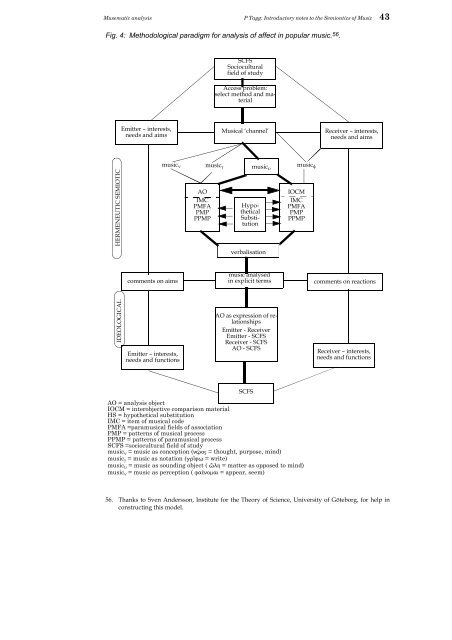Introductory notes to the Semiotics of Music - Philip Tagg's home page
Introductory notes to the Semiotics of Music - Philip Tagg's home page
Introductory notes to the Semiotics of Music - Philip Tagg's home page
Create successful ePaper yourself
Turn your PDF publications into a flip-book with our unique Google optimized e-Paper software.
Musematic analysis P Tagg: <strong>Introduc<strong>to</strong>ry</strong> <strong>notes</strong> <strong>to</strong> <strong>the</strong> Semiontics <strong>of</strong> <strong>Music</strong> 43<br />
Fig. 4: Methodological paradigm for analysis <strong>of</strong> affect in popular music. 56.<br />
HERMENEUTIC SEMIOTIC<br />
IDEOLOGICAL<br />
Emitter – interests,<br />
needs and aims<br />
comments on aims<br />
Emitter – interests,<br />
needs and functions<br />
SCFS<br />
Sociocultural<br />
field <strong>of</strong> study<br />
Access problem:<br />
select method and material<br />
music ν musicγ music υ<br />
AO<br />
IMC<br />
PMFA<br />
PMP<br />
PPMP<br />
<strong>Music</strong>al ‘channel’ Receiver – interests,<br />
needs and aims<br />
Hypo<strong>the</strong>ticalSubstitution<br />
verbalisation<br />
music φ<br />
IOCM<br />
IMC<br />
PMFA<br />
PMP<br />
PPMP<br />
music analysed<br />
in explicit terms comments on reactions<br />
AO as expression <strong>of</strong> relationships<br />
Emitter - Receiver<br />
Emitter - SCFS<br />
Receiver - SCFS<br />
AO - SCFS<br />
SCFS<br />
AO = analysis object<br />
IOCM = interobjective comparison material<br />
HS = hypo<strong>the</strong>tical substitution<br />
IMC = item <strong>of</strong> musical code<br />
PMFA =paramusical fields <strong>of</strong> association<br />
PMP = patterns <strong>of</strong> musical process<br />
PPMP = patterns <strong>of</strong> paramusical process<br />
SCFS =sociocultural field <strong>of</strong> study<br />
music ν = music as conception (n“ow = thought, purpose, mind)<br />
music γ = music as notation (gr„fv = write)<br />
music υ = music as sounding object ( œlh = matter as opposed <strong>to</strong> mind)<br />
musicν = music as perception ( fa§nomai = appear, seem)<br />
Receiver – interests,<br />
needs and functions<br />
56. Thanks <strong>to</strong> Sven Andersson, Institute for <strong>the</strong> Theory <strong>of</strong> Science, University <strong>of</strong> Göteborg, for help in<br />
constructing this model.














